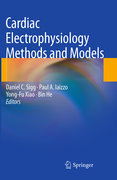
Cardiac electrophysiology methods and models
Sigg, Daniel C.
Iaizzo, Paul A.
Xiao, Yong-Fu
He, Bin
Cardiovascular disease is the major cause of mortality and morbidity in the Western Hemisphere. While significant progress has been made in treating a major sub-category of cardiac disease, arrhythmias, significant unmet needs remain. In particular, every day, thousands of patients die because of arrhythmias in the US alone, and atrial fibrillation is the most common arrhythmia affecting millions of patients in the US alone at a given time. Therefore, there is a public need to continue to develop new and better therapies for arrhythmias. Accordingly, an ever increasing number of biomedical, pharmaceutical, and medical personnel is interested in studying various aspects of arrhythmias at a basic, translational, and applied level, both in industry (ie Biotech, Pharmaceutical and device), and in academia. Not only has our overall understanding of molecular bases of disease dramatically increased, but so has the number of available and emerging molecular, pharmacological or device treatment based therapies. This practical, state-of-the art handbook will summarize and review key research methods and protocols, their advantages and pitfalls, with a focus onpractical implementation, and collaborative cross-functional research. The volume will include visual and easy-to-use graphics, bulleted summaries, boxed summary paragraphs, links to reference websites, equipment manufacturers where appropriate, photographs of typical experimental setups and so forth, to keep this book very focused on practical methods and implementation, and yet, provide enough theory that the principles are clearly understood and can be easily applied. Complete overview of arrhythmias Basic, translational and applied levels of information Practical presentation of information INDICE: Basic Cardiac Electrophysiology: Excitable Membranes.- Principles of Molecular and Cellular Cardio-biology.- Cardiac Action Potentials and Gap Junctions.- Anatomy and Physiology of the Cardiac Conduction System.- The Electrocardiogram and Clinical Electrophysiology.- History and Future of Arrhythmias – drugs, pacemakers, defibrillators, and biological pacemakers.- Principles of Electrophysiological Measurements.- Computer Simulation for Cardiac Electrophysiology.- Molecular Biology Methods.- Cell Culture Methods and Models.- Isolated tissue models.- Isolated heart models.- Small Animal Models.- Large Animal Models.- Optical Mapping and Calcium Imaging.- Patch-Clamp Methods and Protocols for Cellular Electrophysiology of Single Cardiomyocytes.- Electro-Anatomical Mapping and Navigation.- Traditional Mapping and ECG.- Multielectrode Array System for Analysis of Cardiac Conduction and Rhythm in Vitro.- Clinical Imaging Techniques (MRI etc).- Basic Science Perspective.- Translational Scientist Perspective.- Industry Perspective – Device.- Industry Perspective – Biotech/Pharma.- Conclusion.
- ISBN: 978-1-4419-6657-5
- Editorial: Springer
- Encuadernacion: Rústica
- Páginas: 350
- Fecha Publicación: 29/09/2010
- Nº Volúmenes: 1
- Idioma: Inglés
